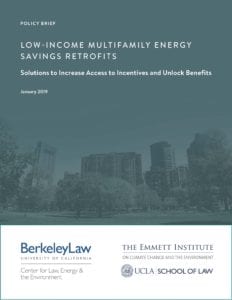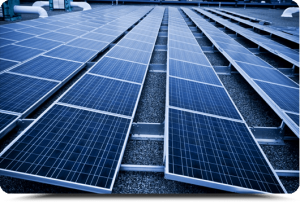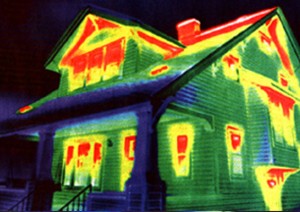 The United Kingdom has been a leader on encouraging building owners to upgrade the energy performance of their properties. The country mandates disclosure of building energy performance during sale or lease to make new owners aware of the inefficiencies. And it launched the “Green Deal” program in 2013:
The United Kingdom has been a leader on encouraging building owners to upgrade the energy performance of their properties. The country mandates disclosure of building energy performance during sale or lease to make new owners aware of the inefficiencies. And it launched the “Green Deal” program in 2013:
The scheme aimed to encourage millions of households to take out loans to fund the cost of work such as installing insulation or new boilers, with the loans paid back in instalments on their energy bills. It was marketed around the idea that the household would end up better off, because the repayments would be lower than savings the household enjoyed from being more energy efficient.
But things didn’t go as planned:
[I]t has been beset by problems from the outset, with high interest rates on loans widely regarded as unattractive, and ministers forced to admit that savings were not guaranteed. Fewer than 4,000 households had signed up for ‘Green Deals’ by the end of July.
The troubles with the UK program mirror the challenges that California has faced with its Energy Upgrade program:
According to an analysis of state data by the San Francisco Chronicle, California has only supported 12,200 home efficiency retrofits under its Energy Upgrade California program since 2011. The stated goal of the program is to service over 100,000 homes.
The culprit in California is the complex administrative process to qualify for the rebates and incentives. I know from personal experience. When I tried to access the financial incentives from Energy Upgrade California when I wanted to add insulation to my attic, the program required an expensive energy audit both before and after, even though I had already had an audit done the calendar year before. So I just skipped the audit and the incentives entirely but still got the work done.
Cracking this nut is difficult. Each building is different, and even though the savings are potentially significant, many property owners don’t want to deal with the hassle or expense of an upgrade to the building. Maybe California and the UK can learn from each other, because we’re definitely going to need to make the process and incentives as seamless as possible to encourage people to undertake these upgrades.
Energy efficiency upgrades and renewable energy arrays for homes and businesses pay for themselves over time through savings on the utility bill. But the big obstacle for many is finding the upfront cash. PACE (Property Assessed Clean Energy) programs overcame that barrier by allowing local governments to pay for this work and have property owners repay them via additional assessments on their property tax bills. Big win-win: communities get more energy efficient and clean energy neighborhoods, limiting pollution and creating good local jobs, while homeowners get access to low-interest financing.
But the federal agency that underwrites over half of the mortgages in the U.S. freaked out in 2010 over the program. The Federal Housing Finance Agency (FHFA) put a stop to its rapid growth across the United States by telling property owners that they might jeopardize their mortgage if they take out a PACE lien. Basically the FHFA didn’t like the idea of local governments having lien priority on these payments in the event of a foreclosure, despite the numerous protections and safeguards included in the program. Since then, some PACE programs have continued, notably in Sonoma County and Riverside. California even created a statewide loan-loss reserve to protect federal interests, but it didn’t satisfy the feds.
Greentech Media now has a hopeful article on how PACE programs are rebounding from the federal hysteria:
It’s not illegal for homeowners backed by Fannie or Freddie to participate in the program. They are simply required to pay off the loan first if they move or refinance their mortgage. That may deter some homeowners from considering a PACE loan, but a lot of them are still making the decision to finance a retrofit through PACE.
Stacey Lawson, the CEO of Ygrene, another large PACE administrator, said in a previous interview that it all comes down to communicating the implications of taking on the loan: “There’s been a lot of fear, uncertainty and misinformation in the marketplace around the risk to homeowners. But it’s really just a simple business decision they have to make.”
Turns our PACE program administrators and homeowners are forging on, undeterred by the federal threats. This is good news for the climate fight and for the economy. And once the federal government reverses its stance (we can hope), the program should proliferate and become a top source for financing clean energy building improvements.
Today, the Center for Law, Energy and the Environment (CLEE) at Berkeley Law and the Emmett Institute on Climate Change and the Environment at UCLA Law are releasing a new report, Data Access for a Decarbonized Grid, which highlights key policy solutions to expand access to the energy data needed to operate a fully decarbonized grid.
Join our webinar on Wednesday, April 7 at 10am PT to learn more.
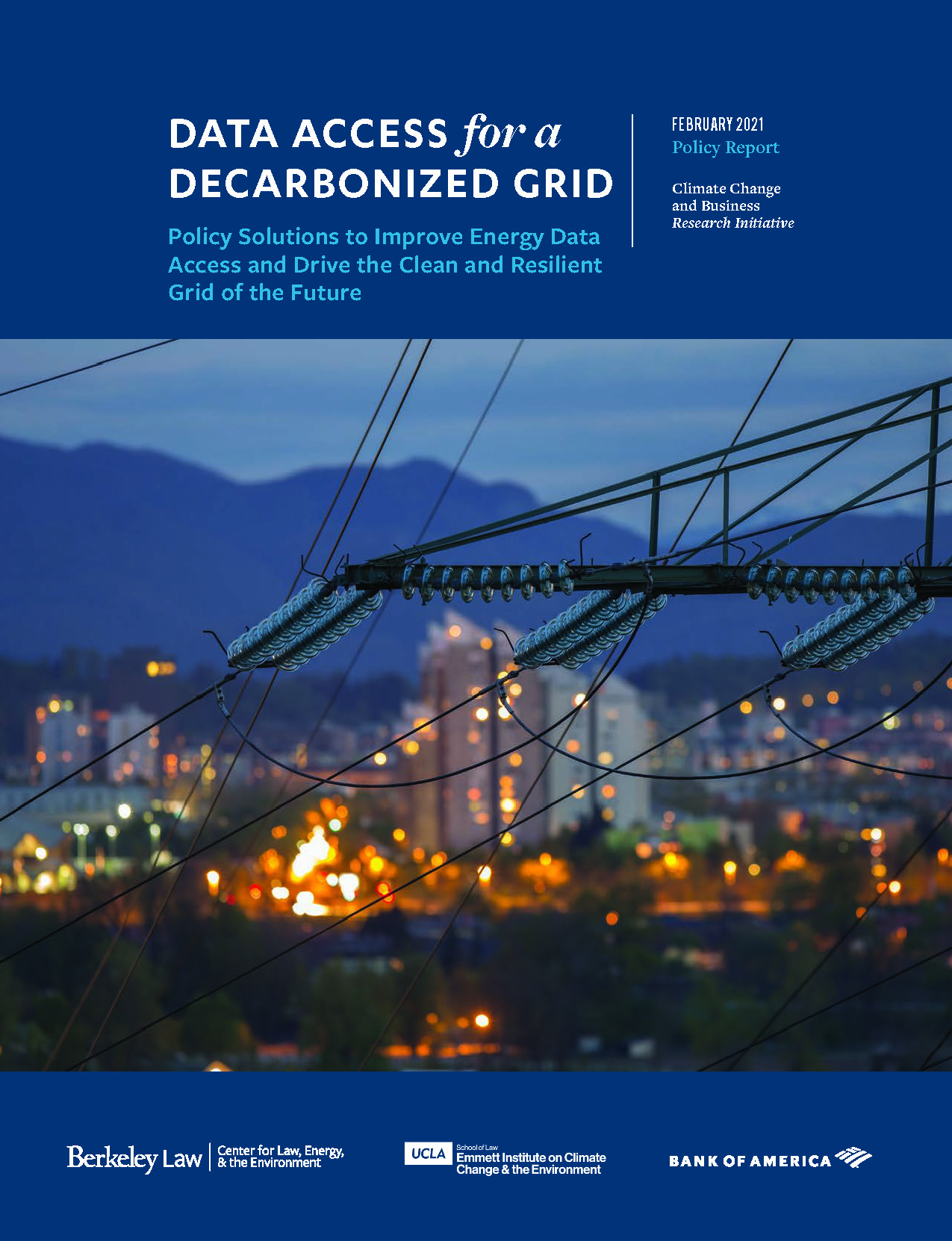
As California approaches the state target of delivering 100 percent zero-carbon power by 2045, state leaders face the challenge of decarbonizing electricity by rapidly expanding the use of renewable energy sources. At the same time, they face increasingly severe heat waves and wildfires that threaten the reliability and resilience of the grid.
Individuals, businesses, and utilities are turning to a growing group of flexible grid technologies to meet this challenge—such as distributed renewables, small-scale battery storage, and smart appliances and building energy management. They are becoming increasingly mainstream and affordable. But these technologies, which facilitate the flexibility needed to deliver reliable power on a fully renewable grid, also rely on constant flows of energy data in order to operate effectively and efficiently.
The data include grid structure and operations data that depict system assets and capacity; customer-level data on consumption and rates; and real-time performance data for distributed generation and storage assets. Utilities, technology providers, and residents already exchange these data in abundant quantities. However, a set of regulatory, privacy, and incentive-based challenges limit the ability of regulators, utilities, and developers to generate and manage the data optimally.
These barriers include utility business and regulatory incentives that reward major physical capital investments over data management initiatives; potentially outdated rules restricting customer data-sharing; and concerns around cybersecurity and physical grid asset security.
To identify solutions to these challenges, CLEE and UCLA Law’s Emmett Institute convened a group of energy data experts in August 2020, and our new report details the solutions including:
- Adopting performance-based regulation of electric utilities to provide financial incentives for high-quality, efficient data generation and management.
- Re-examining the California Public Utilities Commission’s 15/15 rule for customer data aggregation (which sets numerical limits on customer cohorts) and considering use of differential privacy methods instead.
- Modernizing utility IT systems to adapt to rapidly evolving technological and customer needs.
Ultimately, a fully decarbonized electrical supply will require a large-scale restructuring of the grid across generation, distribution, and consumption activities. In the face of growing threats to grid resilience and reliability, California energy leaders will have to help energy producers and consumers throughout the state gain access to the flexible grid technologies needed to maximize efficiency and minimize service disruption. Ensuring the optimal flow of energy data is vital to that effort.
You can access the report and its full set of recommendations here.
You can also learn more about state priorities for increasing access to energy data by joining CLEE and the Emmett Institute for a free webinar on Wednesday, April 7 at 10am PT. Speakers include:
- California Energy Commissioner Andrew McAllister
- Clean energy expert Audrey Lee
- Sky Stanfield of Shute, Mihaly & Weinberger
We will discuss policy opportunities and technology needs to accelerate the transformation of the grid. RSVP here. Hope you can join!
This post was co-authored with Ted Lamm and cross-posted on Legal Planet.
California will need to double the energy efficiency of existing buildings by 2030 in order to achieve the goal of reducing greenhouse gas emissions 40 percent below 1990 levels by that year. While state leaders have adopted aggressive standards for efficiency in appliances and new construction, convincing property owners to undertake retrofits to improve energy performance, from switching out incandescent light bulbs to LEDs to installing energy efficient windows and wall insulation, is a tough task. It’s made even more challenging for low-income residents of multifamily buildings who may not own their units or building common spaces or otherwise lack the fiscal incentives and means to pay for this work.
To address the challenge, the Center for Law, Energy & the Environment (CLEE) at Berkeley Law and UCLA School of Law’s Emmett Institute on Climate Change and the Environment will soon launch a new report, Low Income, High Efficiency (we released a policy brief with some of the top-level findings earlier this year). On Thursday, June 20 at 10am, the law schools will host a free webinar to discuss the report’s recommendations for improving low-income multifamily energy efficiency incentives, with experts including:
- California Energy Commissioner Andrew McAllister
- Peter Armstrong of Wakeland Housing
- Martha Campbell of the Rocky Mountain Institute
The new report, co-authored by CLEE and the Emmett Institute and sponsored by Bank of America, is based on two stakeholder convenings organized to identify solutions to the cost and complexity of efficiency retrofits in the low-income multifamily sector. These buildings face limited access to capital, complex financing arrangements and restrictions, and competing renovation needs. California’s energy regulators and electric utilities operate a number of incentive and rebate programs, but strict income qualification criteria, program complexity, and a lack of adequate energy data can limit uptake.
As described in our policy brief this year, the report will offer a range of solutions to increase access to energy efficiency incentives and unlock environmental, financial, and quality-of-life benefits for owners and residents alike, including:
- Creating a single, statewide “one-stop shop” efficiency program administrator to comprehensively manage incentives and offer users a single point of access.
- Expanding innovative financing mechanisms such as “pay as you save” and third-party “energy budget” arrangements that take advantage of residents’ utility bills and private capital.
- Creating a comprehensive database to help prioritize retrofit projects and support energy data benchmarking and analysis efforts.
Please join us for the free webinar and report release on Thursday, June 20 to discuss these solutions and more.
You can RSVP here. We’ll blog again that week once the full report is publicly available.
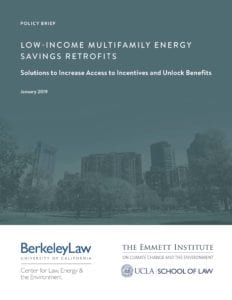 California needs to improve the energy performance of existing buildings in order to meet efficiency and greenhouse gas emission goals, as well as save property owners money on their utility bills. But owners of low-income, multifamily buildings face significant obstacles, including difficult access to capital, complex financing arrangements, and competing renovation needs. Furthermore, residents in these buildings experience a “split incentive” problem that limits owners’ financial interest in upgrades that primarily reduce residents’ utility bills.
California needs to improve the energy performance of existing buildings in order to meet efficiency and greenhouse gas emission goals, as well as save property owners money on their utility bills. But owners of low-income, multifamily buildings face significant obstacles, including difficult access to capital, complex financing arrangements, and competing renovation needs. Furthermore, residents in these buildings experience a “split incentive” problem that limits owners’ financial interest in upgrades that primarily reduce residents’ utility bills.
To address these challenges, UC Berkeley and UCLA Schools of Law are issuing today a new policy brief based on two stakeholder convenings that identify policy solutions to address key barriers, increase access to energy efficiency incentives, and unlock environmental, financial, and quality-of-life benefits for owners and residents alike. Among the solutions:
- The Legislature or Public Utilities Commission could create a single, statewide “one-stop shop” efficiency program administrator for users to obtain information about available programs, determine applicability, submit all filings, manage participation, and receive technical assistance.
- The Legislature could create a long-term fund to support the one-stop shop Administrator and subsidize advanced efficiency measures, allowing owner/developers to plan efficiency projects in line with their long-term obligations.
- State energy regulators could create a comprehensive database to help prioritize retrofit projects and support Energy Commission energy data benchmarking and analysis efforts under AB 802.
You can access the policy brief here. A full-length report detailing the comprehensive findings will be released later this year.
As I blogged about yesterday, the California Energy Commission unanimously approved a new solar mandate for all new residential construction in the year 2020. I spoke to KPCC radio in Los Angeles and Reuters about the decision.
While I think the mandate is sound economically and environmentally, Severin Borenstein at UC Berkeley takes a contrary view on the economics. Severin doesn’t like rooftop solar in general, as opposed to more cost-efficient utility-scale solar, and he foresees problems with ratepayers subsidizing the installations.
For my part, I think it’s clear the state is heading away from the retail credit model of subsidizing excess solar production, which Severin doesn’t like. Instead, state regulators will likely to move to paying the wholesale rate for surplus solar from rooftops, as Hawaii basically now does. So new batteries will likely accompany these home solar installations, because they will be an economically sound technology to capture surplus solar rather than feed it to the grid for a relatively puny wholesale rate. That’s what we see consumers doing in Hawaii in response to the loss of retail credit.
And in that respect, the new commission rules could help, as they also give batteries “compliance credits” to reduce the size of the needed solar system. They also include incentives to move away from natural gas to new homes, as well as other efficiency measures.
Once again, California is taking a strong leadership position on the environment that will benefit clean tech deployment and save new homebuyers money in the process. The decision should be a major boost for these needed technologies.
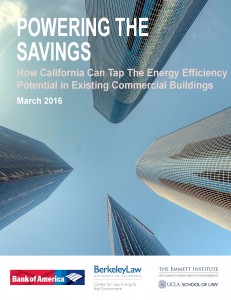 California has an aggressive goal to double the energy efficiency of existing buildings by 2030. The problem though is that building owners don’t seem very interested in having energy retrofit work done on their house or commercial property. We covered this subject in a recent Berkeley/UCLA Law report Powering the Savings, as well as in a September panel event at Berkeley Law.
California has an aggressive goal to double the energy efficiency of existing buildings by 2030. The problem though is that building owners don’t seem very interested in having energy retrofit work done on their house or commercial property. We covered this subject in a recent Berkeley/UCLA Law report Powering the Savings, as well as in a September panel event at Berkeley Law.
A reporter from E&E News attended that event and interviewed a few of us afterwards. Her article (paywalled) described some of the challenges:
The price tag for California’s goal is extremely high. Retrofitting all owner-occupied housing units in California — half of all housing — would cost $180 billion, DeVries estimated. There have been about $4.5 billion worth of retrofits under PACE programs nationwide, mostly in California. “I don’t think we’re going to find the money here,” he said. “We’re going to have to find it elsewhere, which means Wall Street, which means securitizations.”
Wall Street has the appetite, according to DeVries. His company’s latest offering of $220 million in project-backed bonds saw four times more demand than the available supply. The problem is consumer demand. “You can have all the investor interest in the world, and it doesn’t matter one bit,” he said. “The chicken and the egg here — the demand has to come first.”
Figuring out easy, capital market-type financing could help drive this demand, as we’ve seen with rooftop solar. And finding ways to reach building owners during key moments is also important, like when they’re between tenants or when remodeling or appliance replacements are in the works. But at some point, the state may need to move toward mandatory retrofit requirements during times of change in ownership or tenancy, as other jurisdictions have done.
Without these steps, what should be one of the most cost-effective ways to fight climate change may continue to under-perform and under-deliver.
In the fight to save energy and reduce pollution, everyone always says that energy efficiency is the “low-hanging fruit.” That’s because upgrading appliances and building performance typically saves enough energy and therefore money to pay for itself in just a few years.
So why aren’t commercial building owners in particular taking more advantage of the opportunities? And why aren’t lenders promoting these options — particularly when some estimates indicate that there could be $72 billion in market potential that’s being left on the table?
It’s the subject of much insider discussion, and a new report from Institute for Market Transformation (IMT) attempts to analyze the challenge through interviews with building owners and bankers. As Clean Energy Finance Forum reports:
“The key finding of our study was that lenders perceive a low level of demand for energy-efficiency finance,” said Leonard Kolstad, senior program associate at IMT. “That’s something we expected.”
What factors are at the root of this apathy? Building owners are highly skeptical energy retrofits will deliver reliable returns on investment, according to an article Clean Energy Finance Forum published in January 2015.
 What would help? For starters, more outreach to building owners about how they can profit (i.e. raise rents) from retrofits. More building energy data would help, too, to show owners the current inefficiencies and also to prove the savings stream from certain retrofits.
What would help? For starters, more outreach to building owners about how they can profit (i.e. raise rents) from retrofits. More building energy data would help, too, to show owners the current inefficiencies and also to prove the savings stream from certain retrofits.
It would also help to give banks a more formal role in energy efficiency incentive programs, so that banks were involved in utility outreach programs. And banks could likewise include efficiency finance as part of their environmental, social and governance (ESG) programs.
A move to pay-for-performance energy finance, as Berkeley and UCLA Law documented in a new report, could jumpstart this collaboration. As we detail in the report, measuring a predictable savings stream from specific retrofit improvements could give financial institutions something to bank on and finance, akin to rooftop solar.
Otherwise, business-as-usual is ignoring an unusual amount of business.
Even with more buildings, the United States is doing well on energy efficiency, as Greentech Media reports:
New data from the Energy Information Administration reinforces that shift. The agency reported this week that nationwide electricity sales dropped by 1.1 percent in 2015. That marks the fifth time in eight years that U.S. electricity sales have fallen. Meanwhile, yearly construction of new building space is growing by tens of millions of square feet.
“The flattening of total electricity sales reflects declining sales in the industrial sector and little or no growth in sales to the residential and commercial building sectors, despite growth in the number of households and growth in commercial building space,” wrote the agency.
It’s always tough to pinpoint the causes. Certainly the recession made a dent, and so did possibly warmer weather or more growth in warmer climates.
For my part, I would guess that efficiency is now pretty much standard with new building design, and the steep declines in efficient lighting with LEDs are probably having a big impact.
Either way, it’s good news and vital for achieving long-term climate goals.

